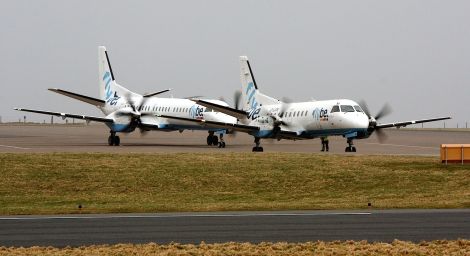News / Plane plummeted 2,900 feet after lightning strike
A PLANE struck by lightning on its way to Shetland in mid December nose-dived to 1,100 feet above sea level on autopilot before starting to climb, an Air Accident Investigation Branch (AAIB) report has found.
The captain of Loganair’s Saab 2000 believed the strike had disabled the plane’s autopilot system and attempted to turn its nose upwards, but the aircraft did not respond as anticipated.
According to the AAIB report, the plane fell to 1,100 feet above sea level travelling at speeds of up to 9,500 feet a minute before beginning to climb.
The incident took place shortly after 7pm on 15 December on a flight carrying 30 passengers from Aberdeen to Sumburgh. The aircraft was around seven nautical miles east of the Shetland mainland’s southernmost tip.
The AAIB report stated: “The flight crew decided to discontinue their approach to Sumburgh Airport because of deteriorating weather ahead.
“After turning and establishing on a southerly heading the aircraft was struck by lightning. The commander made nose-up pitch inputs but perceived that the aircraft did not respond as expected.
“After reaching 4,000 ft [above sea level], the aircraft pitched nose-down and the applicable maximum operating speed was exceeded with a peak descent rate of 9,500 ft per minute.
“The aircraft, however, started to climb after reaching a minimum height of 1,100 ft.”
The report stated that the aircraft was “struck by triggered lightning which caused only minor damage”.
It continued: “Although the pilots’ actions suggested that they were under the impression the autopilot had disengaged at the moment of the lightning strike, recorded data showed that it had remained engaged,”the AAIB report found.
“The pilots’ nose-up pitch inputs were countered by the autopilot pitch trim function, which made a prolonged nose-down pitch trim input in an attempt to maintain its altitude tracking function until it disengaged. This accounted for the perception that the control response was not normal.”
Become a member of Shetland News
One passenger on the flight, Shona Manson, said there had been “an almighty bang and a flash that went over the left wing” of the plane. She said for anyone who was a bad flyer the journey would have been their “worst nightmare”.
Another, Sanna Aitken, said there was “a lot of turbulence after the bang including quite a big drop”.
One Glaswegian passenger was so shaken by the experience that he went home rather than getting on a flight to Shetland the following day.
Become a member of Shetland News
Shetland News is asking its readers to consider paying for membership to get additional perks:
- Removal of third-party ads;
- Bookmark posts to read later;
- Exclusive curated weekly newsletter;
- Hide membership messages;
- Comments open for discussion.
If you appreciate what we do and feel strongly about impartial local journalism, then please become a member of Shetland News by either making a single payment, or setting up a monthly, quarterly or yearly subscription.


























































